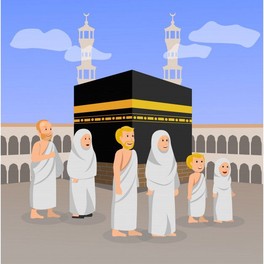How to Enter and Wear Ihram ?

How to Enter or Wear Ihram?
Before entering the state of Ihram, it is Sunnah (recommended) to trim the nails, clean the armpits and pubic area, and perform ghusl (ritual purification). All stitched garments must be removed, and only two pieces of unstitched white cloth are worn—thus, one has donned the Ihram attire. It is essential that the Ihram be white and clean. A very important note: no underwear should be worn underneath.
Where to Wear the Ihram?
The locations for entering Ihram (called Miqat) vary depending on the pilgrim's route. For pilgrims:
-
If arriving at Jeddah Airport: They enter Ihram at the airport using designated changing rooms. Before landing in Jeddah, while crossing the Miqat boundary during the flight, they make their intention (niyyah) for Ihram.
-
If arriving at Madinah Airport: They enter Ihram at their hotel in Madinah on the day they travel to Makkah.
We also demonstrate how to wear the Ihram in the video below.
This mentioned Ihram attire is obligatory for men. For women, there is no such requirement—whatever clothing they are wearing becomes their Ihram attire.
To validly enter Ihram, one must be outside the Miqat boundary. First, two units (rak'ahs) of Ihram prayer are offered (details below). It is Sunnah to recite Surah Al-Kafirun in the first rak'ah and Al-Ikhlas in the second. After completing the prayer, one may ask Allah for ease in performing the Umrah. A sample supplication: “O Allah, I make the intention for Ihram and have prayed two rak'ahs for Your pleasure. Make this Umrah easy for me and accept it from me.” At this point, the person is now in a state of Ihram, and all Ihram prohibitions take effect.
Miqat Points
Miqat refers to the designated boundary points that a person intending to perform Hajj or Umrah must not cross without first entering Ihram. Entering the sacred area (Haram) beyond the Miqat without Ihram is not allowed. The area between Miqat and Haram is called Hill. Each travel direction has a designated Miqat:
-
Dhul-Hulaifah (Abyar Ali)
Miqat for those coming from Madinah. The Prophet Muhammad (peace be upon him) entered Ihram here during his Farewell Pilgrimage. It's the farthest Miqat from Makkah—6 km from Madinah and approximately 426 km from Makkah. -
Dhat 'Irq
Miqat for pilgrims arriving from Iraq. About 94 km from Makkah. -
Juhfah
Miqat for those coming from the Levant (Syria, Jordan, etc.). It is 187 km from Makkah. Pilgrims flying directly to Makkah from Turkey or skipping Madinah usually consider the area aligned with Juhfah (often Rabigh) as their Miqat. -
Qarn al-Manazil (Qarn)
Miqat for those from Najd and eastern Arabia. It is 94 km from Makkah. -
Yalamlam
Miqat for those coming from Yemen. It is the closest Miqat to Makkah, about 54 km away.
Note: Pilgrims arriving by air or sea must enter Ihram when they reach the line aligned with one of these five Miqat points. If one crosses the Miqat boundary without Ihram, a sacrificial penalty (dam) is required, or one must return to the Miqat and enter Ihram properly.
For residents of Makkah:
-
For Hajj: They enter Ihram within the Haram.
-
For Umrah: They must exit the Haram and enter Ihram from the Hill area. The most common place is the Masjid Aisha in Taneem.
How to Enter into Ihram?
Before entering Ihram, it is Sunnah to perform some physical and spiritual preparations:
Physical Cleanliness:
-
Trim nails and clean the armpits and pubic hair.
-
Hair and beard may be trimmed if needed.
-
Perform a full-body purification bath (ghusl), even for women in menstruation or postpartum bleeding.
-
Apply perfume (to the body only, not the Ihram clothes and it should leave no trace).
Ihram Clothing:
-
For men: Two unstitched pieces—izaar (lower) and rida (upper).
-
The head and feet must remain uncovered; sandals with open tops are recommended.
-
For women: They enter Ihram in their regular modest clothing. No special garment is required.
Ihram Prayer and Intention:
-
Perform two units (rak’ahs) of Ihram prayer:
-
In the 1st rak’ah: Recite Surah Al-Kafirun
-
In the 2nd rak’ah: Recite Surah Al-Ikhlas
-
-
After prayer, face the Qibla and make the intention:
“O Allah, I intend to perform Hajj/Umrah for Your sake. Make it easy for me and accept it from me.”
Talbiyah:
Immediately after the intention, the Talbiyah is recited three times:
“Labbayka Allahumma labbayk, labbayka la sharika laka labbayk.
Innal hamda, wan-ni‘mata, laka wal-mulk, la sharika lak.”
Men recite the Talbiyah aloud; women say it quietly or silently. The journey continues with frequent recitation of the Talbiyah, supplications, blessings upon the Prophet, and remembrance of Allah.
What is Prohibited During Ihram?
-
Men wearing any stitched or woven clothing that covers the body
-
Men covering the head or wearing shoes that cover the ankles
-
Cutting or trimming hair or beards
-
Removing body hair or clipping nails
-
Applying perfume to the body or Ihram clothing
-
Engaging in marital relations
-
Arguing, fighting, cursing, or using offensive language
-
Hunting animals (even insects intentionally)
-
Uprooting or damaging plants or trees
If any of these are done unintentionally, the Ihram is not invalidated, but a penalty applies. The type of penalty varies depending on the violation, ranging from feeding the poor to offering a sacrificial animal.
Sources:
Other Contents

